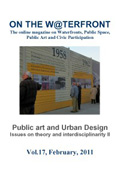Should artists be government supported activists?
Paraules clau:
Public Art, Urban Design, Civic Participation, Urban RegenerationResum
Public art is a multifaceted field of inquiry; it encompasses a wide variety of creative expressions in the public realm. From memorials and historical monuments to contemporary installations and performance events, the possibilities are endless. Each public art program’s intention varies; definitions and generalizations are not commonly held. Some communities see public art as a way of enhancing or personalizing otherwise impersonal spaces. Others view it as a means to activate civic dialogue or provide a vehicle for the community to express its identity. The process of creating public art necessarily involves interaction among many interests; it is a cooperative, somewhat theaterlike production with many individuals playing a part in creating a common goal. As people of different perspectives and positions seek to make decisions cooperatively, the result can be dynamic, inviting, engaging, and sometimes contentious. Even if it is recognized that past expression of public art spoke universalist and modernist themes, recent practices of public art are characterized by a strong collaborative effort between public artist and the community and are intended both to design the physical appearance of the city and to rebuild the relationship that underpin urban life. In such a context the present paper try to trace changes in the aesthetic content of public art form and to relate those changes to the circumstances in which art is produced, evaluated and rewarded. More specifically it calls into question the new role artists are called to play in contemporary public art and it discusses a change in the relation between art and the society. As far as public art seems to make an explicit commitment to a relationship with the world, the present paper tries on the one hand to contextualize this shift and to discuss its apparent novelty compared to past art practices; on the other hand it seeks to enlighten risk and externalities related to the present conception of public art which seems to contradicts the traditional view of art as an alternative/radical practice implying a sort of revolutionary, anti-mainstream outlook and be transformed into a social services practice.Descàrregues
Publicades
2011-02-10
Com citar
Mazzucotelli, Silvia. 2011. “Should Artists Be Government Supported Activists?”. on the w@terfront. Public Art.Urban Design.Civic Participation.Urban Regeneration, no. 17 (February):28-54. https://revistes.ub.edu/index.php/waterfront/article/view/18713.
Número
Secció
Articles
Llicència
 La llicència us permet: Compartir - copiar i redistribuir el material en qualsevol mitjà o format i Adaptar - remesclar, transformar i construir sobre el material per a qualsevol propòsit, fins i tot comercialment. El llicenciador no pot revocar aquestes llibertats mentre l'usuari compleixi els termes de la llicència. Els drets d'autor estan protegits per ISSN 1139-7365. A la revista w@terfront no hi ha restriccions de drets d'autor i permet als autors conservar els drets de publicació sense restriccions.
La llicència us permet: Compartir - copiar i redistribuir el material en qualsevol mitjà o format i Adaptar - remesclar, transformar i construir sobre el material per a qualsevol propòsit, fins i tot comercialment. El llicenciador no pot revocar aquestes llibertats mentre l'usuari compleixi els termes de la llicència. Els drets d'autor estan protegits per ISSN 1139-7365. A la revista w@terfront no hi ha restriccions de drets d'autor i permet als autors conservar els drets de publicació sense restriccions.Aquesta revista no cobra als autors cap taxa per enviar o processar articles.







